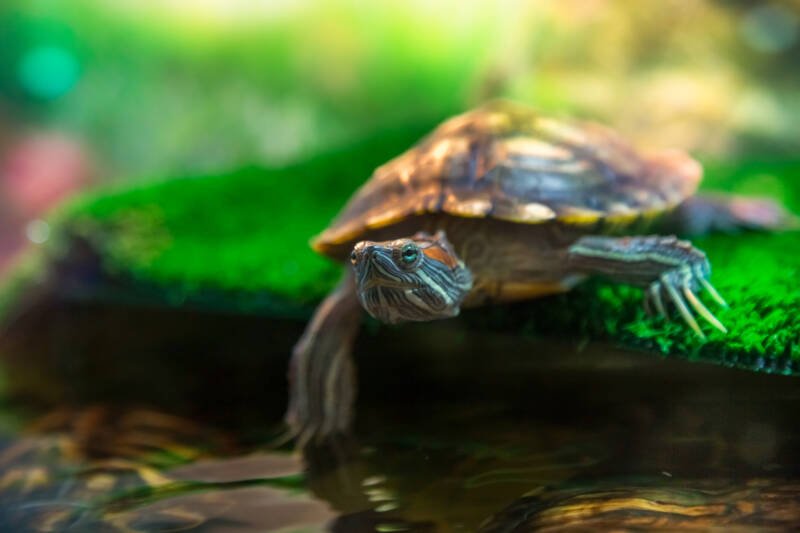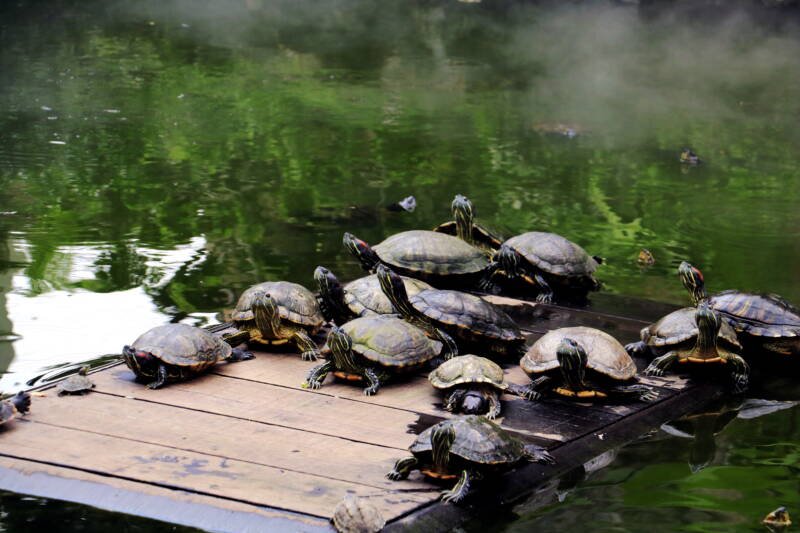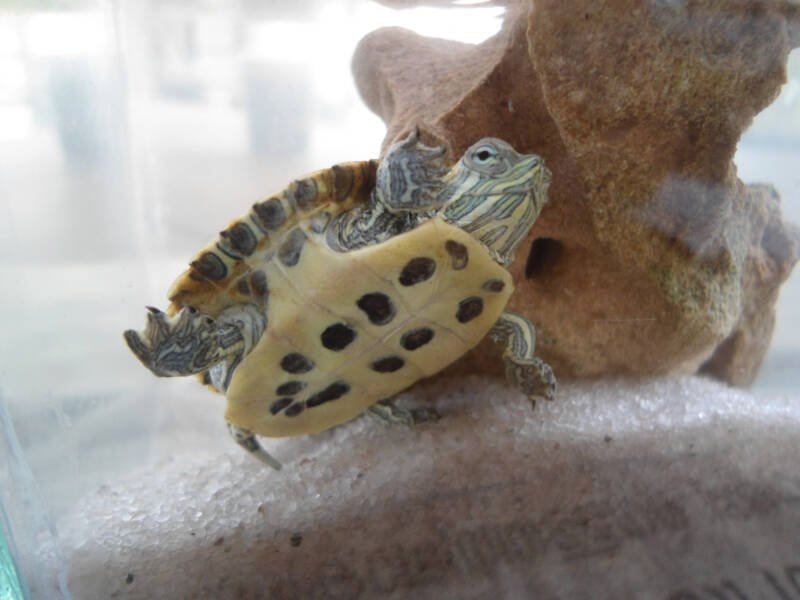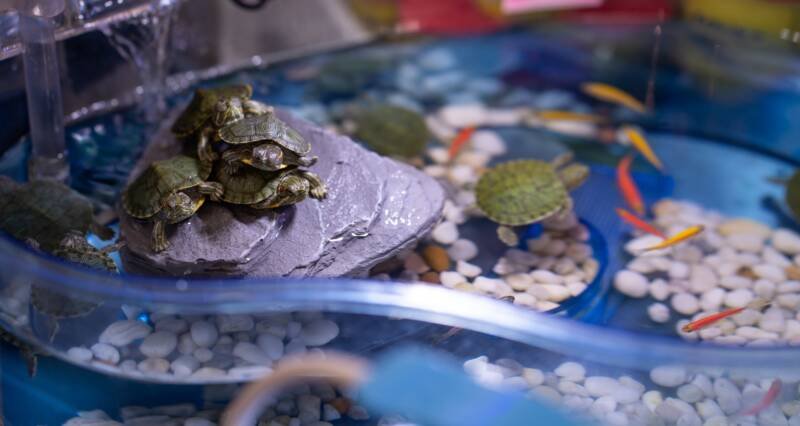Turtles are wonderful, long-lived pets. They also have some very serious requirements to live that long life in a healthy way.
If you want to ensure your turtle lives as long as possible, you have to be able to provide it with many things.
Coincidentally or not, if a lot of these requirements are not met, your turtle will exhibit a wide array of behaviors. One of the most common is your turtle not eating.

There are many reasons why your pet turtle may not be eating. We’re going to discuss quite a few of them and how to resolve your poor turtle friend’s issues.
Reading carefully can help readily identify what may be causing your turtle to not eat.
In this article
Common Reasons Why Your Turtle May Not Be Eating
- Sickness
- Lighting issues
- Dirty enclosure
- Stress
- Age
- Food preferences and special dietary needs
- Pregnancy
- Brumation
- Water temperature
These reasons are not listed in any particular order. It may take a little bit of time to figure out why your turtle isn’t eating.
1. Sickness

Animals get sick, even turtles. If your turtle exhibits any of the symptoms listed below, please take them to a veterinarian as soon as possible.
There are few proper at-home solutions for many common turtle illnesses, so please get your turtle diagnosed and treated professionally.
According to VCA Animal Hospital, these are some of the more common illnesses in turtles.
Shell Infections
The outer layer of keratin on turtle shells protects the vital, living bone underneath.
If this layer is damaged, it presents an opportunity for fungus, bacteria, or viruses to penetrate underneath and reproduce, causing shell infections.
Shell infections are common when the shell is damaged from burns or trauma. Turtle fighting, dropping your turtle, and improper basking areas can all cause shell damage.
Gastrointestinal Parasites
Everyone gets worms. You, your dog, your cat, even your turtle.
These can cause diarrhea and lack of appetite, along with a whole mess of other symptoms.
They’re also incredibly hard to detect without a veterinarian performing a fecal examination.
Abscesses
Abscesses most commonly appear on turtles in and around their ears, appearing as swollen bumps behind the eyes. Common in turtles with a Vitamin A deficiency.
Hypovitaminosis A
Vitamin A deficiency occurs as a result of a poor diet. Turtles fed iceberg lettuce or omnivorous turtles fed an all-meat diet develop this issue.
Symptoms include:
- lethargy
- swollen eyelids
- swollen ears
- kidney failure
- respiratory infections.
Respiratory Infections
Respiratory infections present with:
- excess mucus (seen as bubbling at the mouth, nose, eyes, and ears)
- nasal discharge (runny nose)
- lethargy
- loss of appetite
- wheezing
- continuous neck extension to breathe
- open mouth breathing or gasping.
This is not an exhaustive list, but a small overview of common turtle illnesses that can cause a lack of appetite in your chelonian friend.
2. Lighting Issues

Turtles are ectothermic animals, otherwise known as cold-blooded.
This means they require an outside heat source in order to function properly. They are incapable of producing their own body heat.
Ectothermic animals depend on outside sources of heat to do many things, including digestion.
If they aren’t provided with a proper heat source, their metabolism slows down, reducing their appetite, movements, and overall activity.
If your turtle, or other ectothermic animals, aren’t provided access to necessary temperatures, they’ll develop a host of symptoms and issues, until they eventually die.
To prevent eventual illness and untimely death, you must provide your turtles with a proper basking area.
Requirements for a Proper Turtle Basking Area

Basking Light
I recommend one or two 100w halogen lamps. These should be adjustable height to easily increase or decrease basking temperatures.
The basking area’s hottest point should reach roughly 95-104°F or 35-40°C.
Dry

The basking area needs to be completely out of water and easily accessible to the turtle. This can be accomplished with river stones, driftwood, or premade basking platforms.
It should be large enough, at minimum, for your turtle to fit completely on it and be completely out of water.
Provides a Heat Gradient
I recommend placing the basking area at one end of your turtle’s enclosure. This will help provide a heat gradient, i.e. a hotter end and a cooler end.
Heat gradients allow turtles to more easily regulate their temperature, giving them an area to cool down if they’re too warm.
Thermometer
I highly recommend a digital probe thermometer, placed in the hottest portion of the basking area. This allows you to monitor the basking area’s temperature and make adjustments as needed.
Turtles also require proper UVB emitting light in order to process calcium and prevent metabolic bone disease.
Without a UVB emitting light, turtles will exhibit a lack of appetite and sluggishness, among other eventually fatal side effects. To prevent this, I recommend a UVB 10.0 bulb used in tandem with basking lights.
3. Dirty Enclosure

Turtles produce a lot of waste. Most animals fed a high protein diet do. Most of this waste is passed where the turtle spends most of its time, the water.
Dirty enclosures lead to illness and other issues for your turtle, including a lack of appetite. It’s hard to be hungry when you’re swimming in your own feces.
To prevent this, you should utilize a powerful water filter for the aquatic portion of your turtle’s tank.
I highly recommend a canister filter, as they provide the required flow and filtration capacities for a turtle’s high waste output.
Your filter should have an output of roughly 3x the enclosure’s capacity to ensure proper filtration.For example, if your turtle lives in ~50 gallons (200 l) of water, your filter’s output should be 150 gallons (600 l) per hour (GPH).
I also recommend utilizing a combination of mechanical, biological, AND chemical filtration.
This is one of the few enclosures I recommend activated charcoal in. It helps keep the smell down and removes all sorts of impurities within your turtle’s water.
In addition, try feeding in a separate, dechlorinated water-filled container, like a critter keeper or 10-gallon aquarium, as many turtles defecate WHILE eating.
This helps prevent feces and food waste from entering the enclosure in the first place and goes a long way in maintaining water quality.
Turtle enclosures should also be vacuumed out with a gravel vacuum when doing weekly water changes in order to remove any fallen solid waste.
4. Improper Diet

Do you eat highly processed food from a box every single meal? I hope not.
If you do, should you? Again, probably not.
Your turtles probably don’t want to either. While providing all the “necessary” nutrients for your turtles, eating solely a commercial, processed diet isn’t healthy for your pets.
Turtles will refuse food for many reasons, especially if they just don’t like the food they’re given.
Make sure you research the preferred diet for your turtle’s species. They are incredibly variable and highly specialized, even changing as the turtle ages.
Feed adult turtles roughly 1 cup of food a day, and increase or decrease depending on your turtle’s feeding response.
If using feeder or frozen fish, please be sure to avoid fish high in thiaminase, such as goldfish, minnows, anchovies, sardine, cod, carp, and tuna.
Thiaminase can cause a Vitamin B deficiency in reptiles, a dangerous, sometimes fatal issue.
5. Turtle Brumation

If kept outdoors in areas with seasonal temperature shifts or not provided with the proper temperatures indoors, turtles enter a state of hibernation referred to as brumation.
Brumation is a natural process and is incredibly important for reptiles to experience. However, especially for turtles and tortoises, it is an incredibly dangerous time.
Only experienced reptile keepers should allow their turtles and tortoises to enter a state of brumation.It’s very hard to bring them back safely.
Most common pet turtles, like red-eared sliders, do not require a period of brumation for a healthy, long life.
It’s incredibly difficult to provide the required environment for it indoors.
If your indoor turtle becomes sluggish, inactive, and refuses to eat when the seasons change, double check your temperatures and lighting times to ensure you aren’t allowing brumation to occur.
Low nighttime temperatures are the first indication for your turtles to brumate, so make sure their overnight lows are kept stable, somewhere around 77 °F or 25°C for most common species.
6. Water Temperature

As previously discussed, turtles are ectothermic, or cold-blooded, animals. This means they require an outside heat source to live and function properly.
If your turtle’s water temperatures are too cold, they will lose their appetite, among other pretty bad things.
Low temperatures are fatal for ectothermic animals not equipped to deal with them.
Your turtle’s water temperature should be between 77-86°F or 25-30°C, depending on species. You can accomplish this with an aquarium water heater.
As a rule, I recommend 5 watts for every 1 gallon (4 l) in your enclosure.
You need to raise ~9°F (5°C) above room temperature, so for 20 gallons (80 l) of water raised from 68 to77°F (20°C – 25°C), I recommend a 100w heater, or preferably two 50w heaters.
It’s much easier for two smaller heaters to heat water evenly than it is for a single heater.
It’s also harder for a smaller unit to overheat your water in case of malfunction.
7. Turtle Stress

If your turtle friend isn’t eating, it could very well be a case of stress. Everyone gets stressed, even your animals.
Traveling, physical trauma, new enclosure mates, and other changes in environment can cause stress in your turtles.
If you just brought home a new turtle and they refuse to eat, just wait 2-3 days for them to adjust to their new home. They’ll be fine without eating in the meantime.
It can take a while for a turtle to adjust to change in environment, and one of the ways they react is loss of appetite.
It’s okay, just leave them alone and give them a little time to get comfortable. They’ll have their appetite back soon enough.
8. Age
As turtles age, their growth slows down, and their appetites change.
Omnivorous turtles shift from a high-protein diet to a diet high in greens and vegetables. They also eat less overall as their body’s demands slow down.
If you’ve had your red-eared slider friend for 7 years now, you will notice a change in appetite. It’s just a sign of age and slowed growth.
As turtles hit adulthood, it’s okay, and even recommended, to shift from feeding every single day to feeding every other day, or about 4-5 times a week, according to PetMD.
9. Pregnancy
Here’s a list of questions to ask yourself, if none of the previous entries applies to your particular situation:
- Do you have a whole host of turtles?
- Is one of them specifically refusing food?
- Does that turtle also spend its time trying to dig holes in the dry portions of its enclosure?
- Is that turtle female?
If you answered yes to these questions, congratulations! You’re soon to be the proud grandparent to a turtle clutch!
Good luck with an ever-increasing bale of turtles!
If your turtle is exhibiting these behaviors, they are most likely going to lay a clutch of eggs soon. Turtles tend to refuse food right before laying.
Wait it out, and provide a cup of coconut husk or sphagnum moss to lay eggs in if there’s no area to lay eggs in.
Female turtles even lay unfertilized eggs and exhibit all the same laying behavior. After she lays her clutch, she’ll be eating soon again.
Conclusion
There are a number of possible reasons your turtle is not eating, but with this guide, I’m certain you’ll be able to find the cause of your issues.
If you didn’t notice throughout the article, many of these problems are interconnected.
The easiest way to prevent most complications with turtle-keeping is research. So please, thoroughly learn about all of your pet’s needs and be able to provide them before obtaining your new friend.
Please leave any comments or questions below!